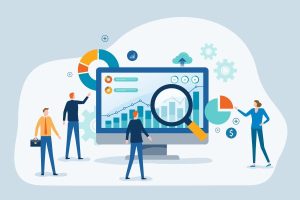Sections Print
Generative AI instruments are more and more being built-in into skilled workflows and enterprise purposes. This raises questions of how such instruments will have an effect on the productiveness of staff and labor demand. This paper presents outcomes of early experimental analysis on these questions for software program builders and discusses the leads to the context of the broader automation literature. The expertise business and software program improvement particularly have been early adopters of those instruments, and as such could provide a preview of impacts throughout the financial system. We additionally spotlight a number of coverage implications, together with the necessity for schooling and upskilling in addition to methods to encourage AI improvement to enrich and never substitute for labor. We intend this paper to be illustrative of anticipated modifications to work and coverage implications arising from the proliferation of generative AI instruments. Generative AI makes use of deep studying fashions skilled on very massive datasets — together with textual content, photographs, video, audio — to yield techniques able to content material era, preliminary reasoning, and versatile question-answering. These techniques have demonstrated professional-level efficiency on various academic and vocational exams in addition to qualitative outcomes that impress skilled software program builders. These capabilities and outputs have led many to take a position about their implications for data work. Software program improvement and the expertise business are early adopters of generative AI applied sciences. Outstanding examples embody GitHub Copilot (Notice that one of many authors is a GitHub worker), Amazon CodeWhisperer, and Replit Ghostwriter, amongst others. AI has demonstrated makes use of throughout the software program improvement lifecycle, from brainstorming purposes, suggesting code, writing documentation, to working checks towards a specification, scanning code for vulnerabilities earlier than releasing and deploying it. Some purposes can produce outputs helpful throughout a number of phases within the lifecycle, for instance taking a picture enter, translating that right into a specification, and subsequently producing code. Such purposes in software program improvement have massive implications for productiveness of builders and society at massive.
Rising developer productiveness Latest research have aimed to find out the productiveness results of generative AI instruments in experimental settings (Peng et al. 2023; Vaithilingam et al. 2022; Mozannar et al. 2022; Campero et al. 2022; Noy and Zhang 2023). Though this literature because it pertains to software program improvement largely focuses on a single software — GitHub Copilot, an AI-pair-programming software that implies code completions as a developer writes software program code or plain textual content feedback — we count on that these research present invaluable insights into the potential results and advantages of AI instruments in software program improvement usually. Peng et al. (2023) recruited 95 skilled programmers by a freelancing platform and instructed them to write down an HTTP server in JavaScript. The remedy group used GitHub Copilot to finish the duty, whereas the management group didn’t. The examine examined two metrics to measure efficiency for every group: job success and job completion time. The outcomes confirmed that the typical completion time of the handled group was 55.8% decrease than that of the management group, suggesting a big improve in software program improvement productiveness. Nonetheless, there was no important impact on job success. By way of heterogeneous results, the examine discovered that sure teams of builders benefited extra from Copilot. Particularly, much less skilled builders with fewer years {of professional} coding expertise, builders going through a heavier workload by way of hours of coding per day, and older builders within the age vary of 25 to 44 skilled higher advantages from utilizing Copilot. Equally, Vaithilingam et al. (2022) carried out a randomized managed experiment with GitHub Copilot, recruiting individuals from two analysis establishments. They developed a within-subject examine the place every participant accomplished two duties: one with entry to Copilot, and one other with out. In contrast to Peng et al. (2023), Vaithilingam et al. (2022) didn’t discover any statistically important impact on completion time between the handled and management teams. Nonetheless, individuals within the examine nonetheless favored utilizing Copilot of their programming workflow. One potential rationalization for this discrepancy might be the individuals’ lack of instruction about Copilot, as some individuals face difficulties in understanding, modifying, and debugging code snippets supplied by GitHub. One conclusion from this analysis is the significance of familiarity with these instruments and a possible studying impact: as builders use AI instruments, the productiveness influence can improve. Campero et al. (2022) investigates the influence of GPT-3 on the efficiency of programmers and non-programmers in writing HTML code individually. Within the first experiment, human programmers with expertisein HTML are requested to carry out coding duties with and with out GPT-3. Within the second experiment, the identical design is used with 50 people with no programming expertise. The examine reveals that GPT-3 considerably enhances human efficiency in each experiments, with programmers attaining a 27% pace enchancment and non-programmers, who couldn’t full the duty with out GPT-3, attaining efficiency as excessive as that of human programmers. Mozannar (2022) takes a unique method and examines how software program builders work together with Copilot in an experimental setting. Utilizing detailed telemetry information, they develop a taxonomy of frequent programmer actions and classify them into two classes: people who require interacting with Copilot, resembling “verifying options” and “ready for options,” and people that don’t require interplay with Copilot, resembling “writing new performance” and “serious about new code to write down.” To know how builders allocate their time throughout these actions, they carried out a person examine with 21 programmers fixing coding duties with Copilot. The principle discovering of the paper is that almost half of the individuals’ time was spent explicitly interacting with Copilot as builders double-checked and edited Copilot options. The results of generative AI instruments should not restricted to software program builders and proof from different occupations might help us perceive the implications. In a web based experiment, Noy and Zhang (2023) present that college-educated staff that have been uncovered to ChatGPT accomplished a writing job sooner (by 0.8 customary deviations) and with increased high quality of output (by 0.4 customary deviations). Echoing the outcomes by Peng et al. (2023) and Campero et al. (2022), inequality between staff decreases, as ChatGPT reduces the productiveness distribution by benefiting low-ability staff extra.
Contemplating impacts on the labor market Earlier AI and automation applied sciences have primarily impacted occupations with a big proportion of routine duties, resembling machine operators and administrative assistants. In distinction, generative AI instruments have the potential to influence varied non-routine job occupations, resembling academics and designers (Felten et al. 2023). Software program improvement supplies an early instance to reveal the influence of the brand new AI applied sciences on data staff. Productiveness shocks by technological improvements should not new for software program improvement. The historical past of computer systems has seen various waves of innovation, the place new applied sciences remodeled how software program will get constructed. Punch playing cards, compilers, high-level programming languages, open supply packages, built-in improvement environments, and code scanning are however just a few examples of those technological advances. Over time, these advances have performed a serious position in a number of developments within the expertise sector: reducing prices, rising demand, and builders being each higher off and higher in quantity. First, prices related to software program and computing have fallen over time. For instance, the U.S. Client Value Index for Info Expertise, {Hardware} and Companies has fallen 92.9% because it was launched in 1988. Second, on the similar time, demand for software program has elevated tremendously as digitization transforms extra industries and different sides of life. The numerous improve in demand for software program, coupled with the declining prices, has led to a rise in demand for software program builders. Third, the info present that software program builders have fared properly throughout these transitions. From 1999 to 2021, for instance, Bureau of Labor Statistics (BLS) information present that individuals working in Laptop and Mathematical Occupations elevated by 77.7%. Their median wage additionally elevated by 15.4% in actual phrases throughout this era.1 The BLS initiatives that this demand for builders will proceed to develop within the years forward. Thus, the potential of generative AI to enormously improve developer productiveness doesn’t essentially promise fewer software program builders. Basically, technological change could both complement or substitute for staff. Concerning substitution, the literature on automation considers how new applied sciences could displace particular occupational duties. Staff displaced from these duties could shift what they do of their each day job and in flip displace different staff, creating ripple results within the financial system. Insofar as builders could spend much less time coding, they might spend extra time on different duties, for instance, consulting with clients or analyzing system efficiency. Acemoglu and Restrepo (2022) have proven that, traditionally, new applied sciences have displaced staff specialised in routine duties. Nonetheless, the definition of a routine job is technology-dependent. This requires an up to date definition for knowledge-work duties that may be automated with generative AI, constructing on latest approaches, resembling these proposed by Brynjolfsson et al. (2018) for suitability for machine studying broadly and by Eloundou et al. (2023) forlarge language fashions, a sort of generative AI. Eloundou et al. (2023) and Felten et al. (2023) provide forward-looking projections of occupations’ publicity to massive language fashions, with each indicating that software program and programming-related occupations are extremely uncovered. The researchers make no claims as as to if publicity will substitute for or complement labor. Such projections may need us count on that builders with some duties or task-relevant abilities impacted by automation would transition to different improvement duties and abilities. Such shifting {of professional} specialties could have little influence on wages, as was seen within the sunsetting of Adobe Flash (Horton and Tambe 2020). Or job change could take the type of lowered drudgery or time looking for data. Extra experimental and observational research of generative AI techniques deployed in real-world settings will present helpful information to guage preliminary projections and perceive whether or not AI enhances or substitutes software program builders. Not all applied sciences are automation, nevertheless; they may also be an augmenting software for present duties or for merely changing outdated applied sciences. Within the former, augmenting case, applied sciences complement labor by rising the productiveness of staff or resulting in the creation of fully new duties. Within the latter case, duties could already be carried out by expertise, and additional innovation merely represents capital deepening — with new expertise supplanting outdated expertise and representing a rise in capital per employee within the financial system — with no net-new automation (Acemoglu and Restrepo 2018). For instance, if a generative AI software have been to interchange an automatic rule-based code scanning system, this is able to not be anticipated to alter internet demand for human labor. One could argue that the combination of generative AI instruments like GitHub Copilot into code editors which have beforehand supported different types of autocomplete equally constitutes capital deepening. We may count on new duties to be created as builders work on new classes of software program, as has occurred up to now with the rise of non-public computing, internet, cell, cloud, and extra. Such duties typically end in fully new jobs. For instance, Autor et al. (2022) discover that 74% of individuals employed in skilled occupations in 2018 labored in job titles that didn’t exist in 1940. Wanting on the historical past of software program improvement and early productiveness outcomes with generative AI, we might count on this to proceed: Though what they construct and the instruments they use will change, builders will seemingly be in higher demand than ever.
Coverage implications Generative AI-powered instruments for software program improvement are a latest invention. If historical past is any indication, large-scale results will take time, probably for much longer than these constructing the expertise anticipate (David 1990). Amid these modifications, public coverage may have an essential position in guiding the widespread adoption and helpful use of generative AI. Though it’s early, there’s promise that these instruments could enhance the skilled efficiency of builders and slim the hole between greatest and worst performers. Extra analysis is warranted, but when preliminary findings maintain, then these instruments may empower extra folks to maneuver into careers within the expertise business, serving to to satisfy rising demand for software program builders in lots of economies. Software program builders are continuously studying. They repeatedly undertake new applied sciences, instruments, and frameworks so as to keep related. Expertise that employers count on of software program engineers change significantly over time, with greater than a 30% change between 2015 and 2022 based on LinkedIn information. Thus, the training concerned in adopting generative AI instruments resembles extra a continuation than a discontinuity. Nonetheless, there’s purpose to suspect that generative AI could make extra professions resemble software program improvement, the place continuous studying and adoption of recent instruments is rewarded and probably essential. Employers and policymakers alike ought to take steps to help staff in lifelong studying. Within the short-term, employers ought to encourage their workers to experiment with generative AI instruments and to share what they’ve discovered, whether or not in devoted brainstorms, hackathons, or different casual settings. Over time, as greatest practices and curricula on tips on how to successfully use these instruments emerge, policymakers ought to encourage companies to offer time and help to workers so as to construct these new abilities. Generative AI could empower extra folks to write down code, even when they don’t work in a technical position. Because the financial system continues its transformation in direction of rising digitization, studying to code stays a invaluable ability. At the same time as AI could generate a higher proportion of software program code, the psychological mannequin of articulating a specification or prompting for particular features will assist staff benefit from generative AI instruments. Policymakers ought to help efforts to extend academic alternatives to make use of these instruments inschool, responsibly and in acknowledgement of their limitations. This begins with guaranteeing primary digital fairness, together with that college students have enough entry to broadband web and entry to pc science in main schooling. Whether or not formally in courses or informally in hackathons or golf equipment, increasing the alternatives that college students and non-students alike have to make use of these instruments in supervised methods might help adapt the workforce to the age of AI. Though there’s purpose to imagine that the productiveness results of widespread adoption of those instruments could take time to manifest, underlying generative AI expertise is anticipated to proceed to advance. As soon as builders undertake these instruments and organizations combine them into processes, additional modifications could be anticipated because the underlying AI fashions could be swapped out for improved ones. The end result might be gradual adoption punctuated by a interval of fast change in skilled workflows as future AI fashions reveal functionality enhancements. In constructing new generative AI instruments, you will need to accomplish that with an understanding of their potential impacts on customers’ livelihoods. Klinova and Korinek (2021) provide an preliminary framework for companies constructing AI instruments to guage their potential results on employment alternatives and inequality. The Partnership on AI’s Shared Prosperity Initiative is constructing on this work to assist these creating AI instruments steer improvement to profit staff. Policymakers can shift incentives to help AI improvement that enhances as an alternative of substitutes for labor by, amongst different issues, reversing the established order within the U.S. of labor being taxed extra closely than capital (Brynjolfsson 2022). In the long term, novel approaches resembling a common primary revenue that robotically scales with the non-labor share of nationwide revenue could also be warranted (Korinek and Juelfs 2022). Immediately, as policymakers weigh responses, job influence projections like these from Eloundou et al. (2023) and Felten et al. (2023), validated with experimental outcomes together with these summarized on this paper for software program improvement, can present data for concentrating on and prioritizing sources to susceptible staff. As with different basic objective applied sciences earlier than it, generative AI will carry important financial advantages as it’s adopted throughout society. Efficient coverage can encourage accountable use of the expertise so as to seize these advantages whereas guaranteeing that the workforce is able to undertake and profit from these improvements. Software program builders are early adopters of those applied sciences and provide policymakers a number one indicator for the way forward for work.





